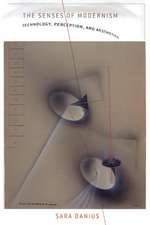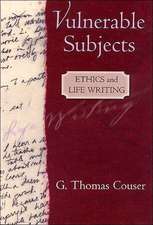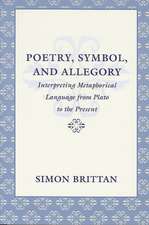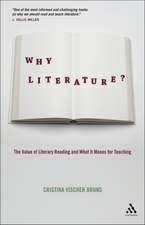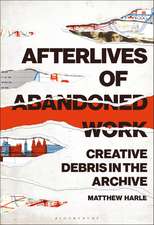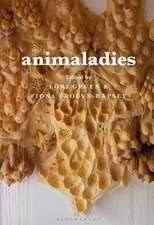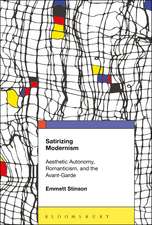The Moral Worlds of Contemporary Realism
Autor Dr. Mary K. Hollanden Limba Engleză Paperback – 8 iul 2020
| Toate formatele și edițiile | Preț | Express |
|---|---|---|
| Paperback (1) | 169.39 lei 3-5 săpt. | |
| Bloomsbury Publishing – 8 iul 2020 | 169.39 lei 3-5 săpt. | |
| Hardback (1) | 656.54 lei 6-8 săpt. | |
| Bloomsbury Publishing – 8 iul 2020 | 656.54 lei 6-8 săpt. |
Preț: 169.39 lei
Preț vechi: 217.35 lei
-22% Nou
Puncte Express: 254
Preț estimativ în valută:
32.42€ • 33.49$ • 26.98£
32.42€ • 33.49$ • 26.98£
Carte disponibilă
Livrare economică 05-19 martie
Preluare comenzi: 021 569.72.76
Specificații
ISBN-13: 9781501362620
ISBN-10: 1501362623
Pagini: 312
Dimensiuni: 140 x 216 x 23 mm
Greutate: 0.52 kg
Editura: Bloomsbury Publishing
Colecția Bloomsbury Academic
Locul publicării:New York, United States
ISBN-10: 1501362623
Pagini: 312
Dimensiuni: 140 x 216 x 23 mm
Greutate: 0.52 kg
Editura: Bloomsbury Publishing
Colecția Bloomsbury Academic
Locul publicării:New York, United States
Caracteristici
Looks at canonical contemporary writers (David Foster Wallace, Don DeLillo) as well as less well known writers (Ruth Ozeki, Ted Chiang, Steve Tomasula)
Notă biografică
Mary K. Holland is Professor of English at The State University of New York, New Paltz, USA. She is the author of Succeeding Postmodernism: Language and Humanism in Contemporary American Literature (Bloomsbury 2013) and co-editor, with Stephen J. Burn, of Approaches to Teaching David Foster Wallace (2019).
Cuprins
List of FiguresAcknowledgmentsPreface: The Problem of "Realism"Introduction: A Brief History of Realisms1. Metafictive Realism: David Foster Wallace and the Future of (Meta)Fiction 2. The Work of Art after the Mechanical Age: Materiality, Narrative, and the Real in the Fiction of Steve Tomasula3. Material Realism and New Materialism in Literature from the 1990s to the Present4. Quantum Realism: On Ted Chiang's "Story of Your Life" and Ruth Ozeki's A Tale for the Time Being 5. Quantum Realism Case Study: Don DeLillo's The Body Artist Conclusion: Realism and Periodizing after PostmodernismBibliographyIndex
Recenzii
A brilliant and scholarly theoretical synthesis of realism in America . Three new types of Realism are illustrated in the following chapters devoted to authors such as David Foster Wallace, Steve Tomasula, Ted Chiang, Ruth Ozeki, Don DeLillo, and an impressive number of other writers that testifies to Holland's broad and erudite knowledge of the literary production of the new millennium . Holland draws up a particularly convincing inventory of the most recent and innovative object-texts called 'artifacts' or 'assemblages' that further dissolve the distinction between language and matter . brilliantly commented upon and analyzed. The most innovative and impressive contribution of the book, which together reveals Holland's talents for fine reading, theoretical elaboration, and research, appears in the final chapters on quantum realism and DeLillo's The Body Artist (2001) in particular, of which she delivers a masterful interpretation and an exciting study of the manuscripts available at the Harry Ransom Center in Austin . A luminous, dense, complex, and convincing book that should be read by every student interested in 'post-postmodern' fiction and theory.
Holland [takes on] the endlessly vexed notion of realism by offering a framework for understanding it beyond the contentious and irresolvable debates about what it means to refer to certain writing as realistic . Moral Worlds's most significant insight: language, the sole, imperfect system of accessing and representing reality, does not inhibit our ability to engage with the world but, rather, precisely because of its limitations, parallels the human experience of limited sensory perception.
Rigorous yet lucid, blending technical adeptness with ethical urgency, The Moral Worlds of Contemporary Realism returns us to a reality that our most innovative writers are only just now beginning to reveal.
Reading on contemporary fiction, one seldom encounters criticism that irrevocably transforms the interpretation of a given text. This is one of those rare occasions. Holland invites us to think about contemporary US fiction in a challenging way that contributes to debates about post-postmodernism.
Imagine a novel as an object in the world: not the imaginative dream that readers are normally invited to get lost in, but a novel with a body that has to be confronted. As Mary Holland argues, contemporary understandings of the world, and the Material Turn in philosophical concepts of the human and of nature, have also energized the 21st century novel--a conceptual pivot as fundamental as the turn to psychology or language during the modern or postmodern periods. Cultural sea changes so profound that they drive a rethinking of all the arts occur only once or twice in a generation: The Moral Worlds of Contemporary Realism is an exciting, field-changing analysis of how today, the new-material novel revitalizes print through its entanglement with readers and the stuff of the world--and the consequences wrought by these new realisms.
The Moral Worlds of Contemporary Realism radically and fruitfully upends all the critical truisms about realism(s), bringing both sanity and clarity to central literary and literary historical periodizing debates. By bringing together all the relevant theory, astute, insightful criticism, and, most significantly, innovative literary practice, it blows open all totalizing models of language/narrative/'real' world relations to theorize the fiction written in our twenty-first century 'reality.' This is an acutely analytic, intellectually generous, meticulously researched book that puts metafiction in its (real) place.
What is the realism that comes after postmodernism? Many critics of contemporary fiction have sought to answer this question, but none has had Mary Holland's encyclopedic mastery of the materials necessary to do so in a way that seems fully responsive to the possibilities of the novel in our time. This book works on many levels: as a useful primer on what "realism" has meant in U.S. literature from the 19th century to the present; as a dazzlingly sure-handed tour of recent turns in the dialectic of experimental fiction that have pressed the term on our attention again; as an eloquent case for the ethical implications of all of our attempts to know what reality really is.
Focusing on literary form, technique, and genre, Mary K. Holland's The Moral Worlds of Contemporary Realism compares contemporary 'realist' writers such as David Foster Wallace, Steve Tomasula, and Ted Chiang to nineteenth-century versions of realism, arguing that 'realism' is best understood as writing emerging at historical junctures when social consensus about the real is undergoing paradigmatic changes. Infused with her own passion for reading, writing, and teaching, her analyses of these challenging writers resonate with authenticity, moral clarity, and deep understanding of how literary texts achieve their effects. Highly recommended for anyone interested in the past, present, and future of realistic fictions.
Holland [takes on] the endlessly vexed notion of realism by offering a framework for understanding it beyond the contentious and irresolvable debates about what it means to refer to certain writing as realistic . Moral Worlds's most significant insight: language, the sole, imperfect system of accessing and representing reality, does not inhibit our ability to engage with the world but, rather, precisely because of its limitations, parallels the human experience of limited sensory perception.
Rigorous yet lucid, blending technical adeptness with ethical urgency, The Moral Worlds of Contemporary Realism returns us to a reality that our most innovative writers are only just now beginning to reveal.
Reading on contemporary fiction, one seldom encounters criticism that irrevocably transforms the interpretation of a given text. This is one of those rare occasions. Holland invites us to think about contemporary US fiction in a challenging way that contributes to debates about post-postmodernism.
Imagine a novel as an object in the world: not the imaginative dream that readers are normally invited to get lost in, but a novel with a body that has to be confronted. As Mary Holland argues, contemporary understandings of the world, and the Material Turn in philosophical concepts of the human and of nature, have also energized the 21st century novel--a conceptual pivot as fundamental as the turn to psychology or language during the modern or postmodern periods. Cultural sea changes so profound that they drive a rethinking of all the arts occur only once or twice in a generation: The Moral Worlds of Contemporary Realism is an exciting, field-changing analysis of how today, the new-material novel revitalizes print through its entanglement with readers and the stuff of the world--and the consequences wrought by these new realisms.
The Moral Worlds of Contemporary Realism radically and fruitfully upends all the critical truisms about realism(s), bringing both sanity and clarity to central literary and literary historical periodizing debates. By bringing together all the relevant theory, astute, insightful criticism, and, most significantly, innovative literary practice, it blows open all totalizing models of language/narrative/'real' world relations to theorize the fiction written in our twenty-first century 'reality.' This is an acutely analytic, intellectually generous, meticulously researched book that puts metafiction in its (real) place.
What is the realism that comes after postmodernism? Many critics of contemporary fiction have sought to answer this question, but none has had Mary Holland's encyclopedic mastery of the materials necessary to do so in a way that seems fully responsive to the possibilities of the novel in our time. This book works on many levels: as a useful primer on what "realism" has meant in U.S. literature from the 19th century to the present; as a dazzlingly sure-handed tour of recent turns in the dialectic of experimental fiction that have pressed the term on our attention again; as an eloquent case for the ethical implications of all of our attempts to know what reality really is.
Focusing on literary form, technique, and genre, Mary K. Holland's The Moral Worlds of Contemporary Realism compares contemporary 'realist' writers such as David Foster Wallace, Steve Tomasula, and Ted Chiang to nineteenth-century versions of realism, arguing that 'realism' is best understood as writing emerging at historical junctures when social consensus about the real is undergoing paradigmatic changes. Infused with her own passion for reading, writing, and teaching, her analyses of these challenging writers resonate with authenticity, moral clarity, and deep understanding of how literary texts achieve their effects. Highly recommended for anyone interested in the past, present, and future of realistic fictions.







